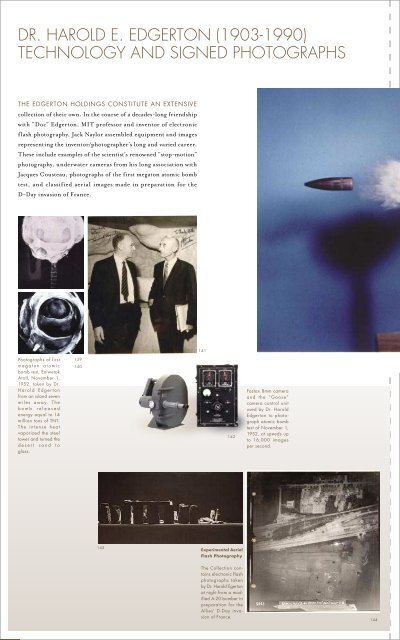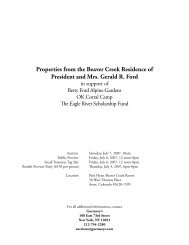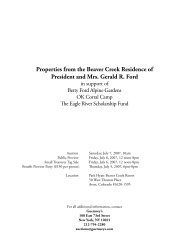THE NAYLOR COLLECTION
THE NAYLOR COLLECTION
THE NAYLOR COLLECTION
You also want an ePaper? Increase the reach of your titles
YUMPU automatically turns print PDFs into web optimized ePapers that Google loves.
DR. HAROLD E. EDGERTON (1903-1990)<br />
TECHNOLOGY AND SIGNED PHOTOGRAPHS<br />
<strong>THE</strong> FIRST PRINT MADE IN AMERICA:<br />
REVEREND COTTON MA<strong>THE</strong>R<br />
OF BOSTON<br />
<strong>THE</strong> EDGERTON HOLDINGS CONSTITUTE AN EXTENSIVE<br />
collection of their own. In the course of a decades-long friendship<br />
with “Doc” Edgerton, MIT professor and inventor of electronic<br />
flash photography, Jack Naylor assembled equipment and images<br />
representing the inventor/photographer’s long and varied career.<br />
These include examples of the scientist’s renowned “stop-motion”<br />
photography, underwater cameras from his long association with<br />
Jacques Cousteau, photographs of the first megaton atomic bomb<br />
test, and classified aerial images made in preparation for the<br />
D-Day invasion of France.<br />
146<br />
THIS 1727 ENGRAVING WAS<br />
made by Joseph Church from a<br />
mezzotint portrait of Reverend<br />
Cotton Mat her painted by<br />
Boston’s Peter Pelham. Reverend<br />
Mather (1663-1728), a scholar<br />
of history, science, biography<br />
and theology, wrote some 380<br />
works and succeeded his father,<br />
Reverend Increase Mather, as<br />
pastor of Boston’s Old North<br />
Church.<br />
141 145<br />
Photographs of first<br />
m e g a t o n a t o m i c<br />
bomb test, Eniwetok<br />
Atoll, November 1,<br />
1952, taken by Dr.<br />
H a r o l d Ed g e r t o n<br />
from an island seven<br />
m i l e s a w a y. T h e<br />
b o m b r e l e a s e d<br />
energy equal to 14<br />
million tons of TNT.<br />
T h e intens e h e a t<br />
vaporized the steel<br />
tower and turned the<br />
d e s e r t s a n d t o<br />
glass.<br />
139<br />
140<br />
142<br />
Fastax 8mm camera<br />
and t h e “G o ose”<br />
camera control unit<br />
used by Dr. Harold<br />
Edgerton to photograph<br />
atomic bomb<br />
test of November 1,<br />
1952, at speeds up<br />
to 16,000 images<br />
per second.<br />
148<br />
Underwater<br />
Photography<br />
143<br />
Experimental Aerial<br />
Flash Photography<br />
The Collection contains<br />
electronic flash<br />
photographs taken<br />
by Dr. Harold Egerton<br />
at night from a modified<br />
A-20 bomber in<br />
preparation for the<br />
Allies’ D-Day invasion<br />
of France.<br />
144<br />
First Sports Photos<br />
Made by Electronic<br />
Flash<br />
These 10 experimental<br />
8-by-10-inch photographs<br />
of the 1946<br />
bout between prizefighters<br />
Joe Louis and<br />
Billy Conn were taken<br />
by Dr. Harold<br />
Egerton. They were<br />
the world’s first electronic<br />
flash photo -<br />
graphs of a sporting<br />
event.<br />
147<br />
Featuring Jacques<br />
Cousteau’s Rolleimarin<br />
deep-water camera,<br />
The Collection’s<br />
marine photographic<br />
e q u i p m e n t a l s o<br />
includes a Nikon<br />
35 mm camera designed<br />
to withstand<br />
water pressure at a<br />
depth of 160 feet; a<br />
1957 Mako Shark<br />
camera; a Fuji singleuse<br />
35 mm camera<br />
in a special underwater<br />
housing; and<br />
an underwater strobe<br />
light, an invention of<br />
Dr. Harold Egerton,<br />
which was pressurized<br />
to a depth of<br />
200 feet.<br />
Alexander<br />
Graham Bell<br />
Memorabilia<br />
Bell memorabilia in<br />
The Collection include<br />
a photograph<br />
of the prolific inventor<br />
demonstrating<br />
his “iron box” telephone<br />
and a photo<br />
of the hydroplane,<br />
yet another of his<br />
inventions.<br />
149




